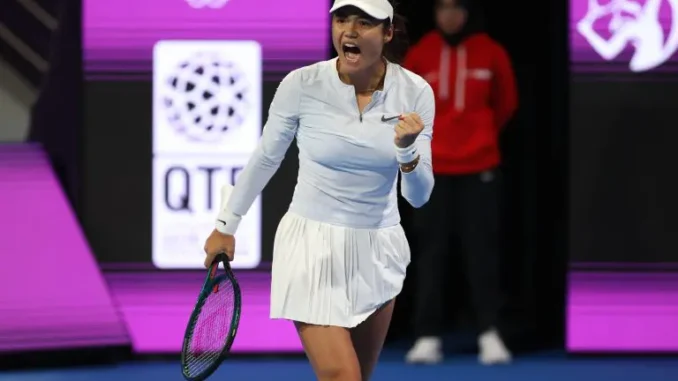
In the cutthroat world of elite tennis, where a single forehand can shatter dreams or forge legends, Emma Raducanu’s 2025 campaign has unfolded like a gripping epic—full of dazzling highs and gut-wrenching lows. The 22-year-old British prodigy, immortalized as the 2021 US Open queen who shocked the globe as a qualifier, embodies untapped genius and fierce resolve. But as golden autumn winds sweep Asia’s hard courts, a chilling new benchmark exposes her season’s chaos: a sharp drop in the Universal Tennis Rating (UTR) standings. From the lofty heights of No. 1 earlier this year, Raducanu has crashed to 17th—a fall that echoes her latest misfortunes and fuels growing anxiety among her devoted followers and sharp-eyed experts.
The UTR algorithm, celebrated for its razor-sharp focus on immediate form over seasonal averages, delivers a raw snapshot of a player’s edge. Diverging from the WTA’s 52-week cycle, where Raducanu holds a solid top-30 berth, UTR prioritizes fresh results, showering bonus points on bold upsets against top seeds. This inclusive tool, bridging pros and everyday players, celebrates the rush of balanced battles. Raducanu’s dive from the summit—sparked by her electric grass-court charge at Queen’s Club and sizzling North American hard-court runs—bites harder because it reveals tennis’s brutal volatility, where glory evaporates in an instant.
This nosedive to 17th trails a punishing Asian tour that’s challenged her not only technically but emotionally. Mere days ago in Wuhan, oppressive humidity cloaked the court like a curse, mirroring the burden of hype. Coming off a Beijing quarterfinal surge, Raducanu ignited against American Ann Li, her explosive forehand and tireless retrieval dominating the opener. Yet, as fatigue crept in, vertigo ambushed her mid-rally. Down 6-1, 4-1, she signaled for aid, medics monitoring her skyrocketing pulse. “I need to push harder physically,” she confessed in a raw social media update, blending defiance with disappointment. “Shame I couldn’t continue there, but thank you for the messages—feeling better now.” The withdrawal revived ghosts of her 2023 ordeals—wrist and ankle surgeries that bench-warmed her for half a year.
The nightmare persisted in Ningbo, where 89% humidity turned every point into a slog. Facing China’s wildcard Zhu Lin (world No. 219, a tour veteran), Raducanu scrapped for the first set in a 60-minute thriller marred by four service breaks. Drawing on the smarts that clinched her New York triumph, she snatched it 6-3 on her fifth set point, her baseline bombs echoing like artillery. But the second frame darkened fast. Broken to trail 3-4, she paused for medical help, staff probing her blood pressure beneath a towel shield. She clawed to 4-4, yet Zhu struck back, stealing the set 6-4 despite erratic serves.
The third set was pure devastation. Raducanu dropped serve at once, then grimaced, cradling her lower back and stretching desperately. A second timeout ensued, the physio kneading her sprawled form on the baseline. Hampered mobility let Zhu surge, breaking back to 1-2 futilely before conceding four games in a row for a crushing 6-1 close. Zhu pocketed 16 of the final 19 points in a 2-hour-27-minute epic. The victor, all class, summed up the drain: “It was a very tough match, I couldn’t find my rhythm, but I kept moving, kept patient, to get the rhythm, to get the final set. Also, there were some issues with Emma in the final set. It’s not easy for both of us, it’s very near the end of the season.” For Raducanu, it sealed a third straight defeat and a dismal five-for-five skid in third sets—worlds away from her straight-set demolition of Leylah Fernandez in teenaged Slam splendor.
The fallout cascades wide. UTR’s fresh leaderboard crowns Aryna Sabalenka at No. 1, her Wuhan final glow intact despite Jessica Pegula’s edge. Iga Swiatek shadows at No. 2, Amanda Anisimova’s revival—Slams finals and Beijing glory—claims third, and Coco Gauff seals the top five, heralding tennis’s young blood revolution. Raducanu’s 17th slots her below Naomi Osaka’s 10th, whose return evokes Slam echoes. It’s a sobering mirror: summer No. 1 peaks from grass wizardry and U.S. triumphs now crumbled by “tight defeats”—wasted match points versus Pegula in Beijing (6-0 third rout) and Krejcikova in Seoul (6-1 breaker).
Pulling back, 2025 shines as sparks in the storm. Her 5-9 three-set mark flags stamina woes, but triumphs tease greatness: Queen’s quarters making her British No. 1, steady Australian Open advances preserving her Melbourne magic. Behind the scenes, her crew—hitting partner Alexis Canter, trainer Daniel Pohl, remote coach Francisco Roig in Barcelona—anchors her fight. Still, the wear accumulates. “Everyone will go nuts if she makes the wrong decision,” a commentator cautioned, voicing burnout alarms. Raducanu eyes weaponizing a signature stroke for top-20 seeding at the 2026 Australian Open, mere months off.
Just two events remain: Tokyo’s Pan Pacific Open from October 20, then Hong Kong’s WTA 250—skipped last year to injury—as either salvation or specter. Upsets over top-30 rivals here could rocket her UTR skyward; the formula promises, “If Raducanu can record some wins against higher-ranked opponents in the final weeks of the season, her UTR ranking will leap up quickly,” a rallying cry for her drive.
As 2025 fades, Raducanu teeters on the precipice. The Flushing Meadows conqueror, once pure exhilaration, now battles bodily betrayal with indomitable will. Can she ignite that “need to push harder physically” spark for a resurgence, or will the descent drag into introspective winter? Tennis’s elegant savagery spares none. Yet for this script-defying star, redemption beckons irresistibly. From British grass to Tokyo neon, admirers wait rapt—Emma Raducanu pens her saga, stroke by unyielding stroke.
Leave a Reply